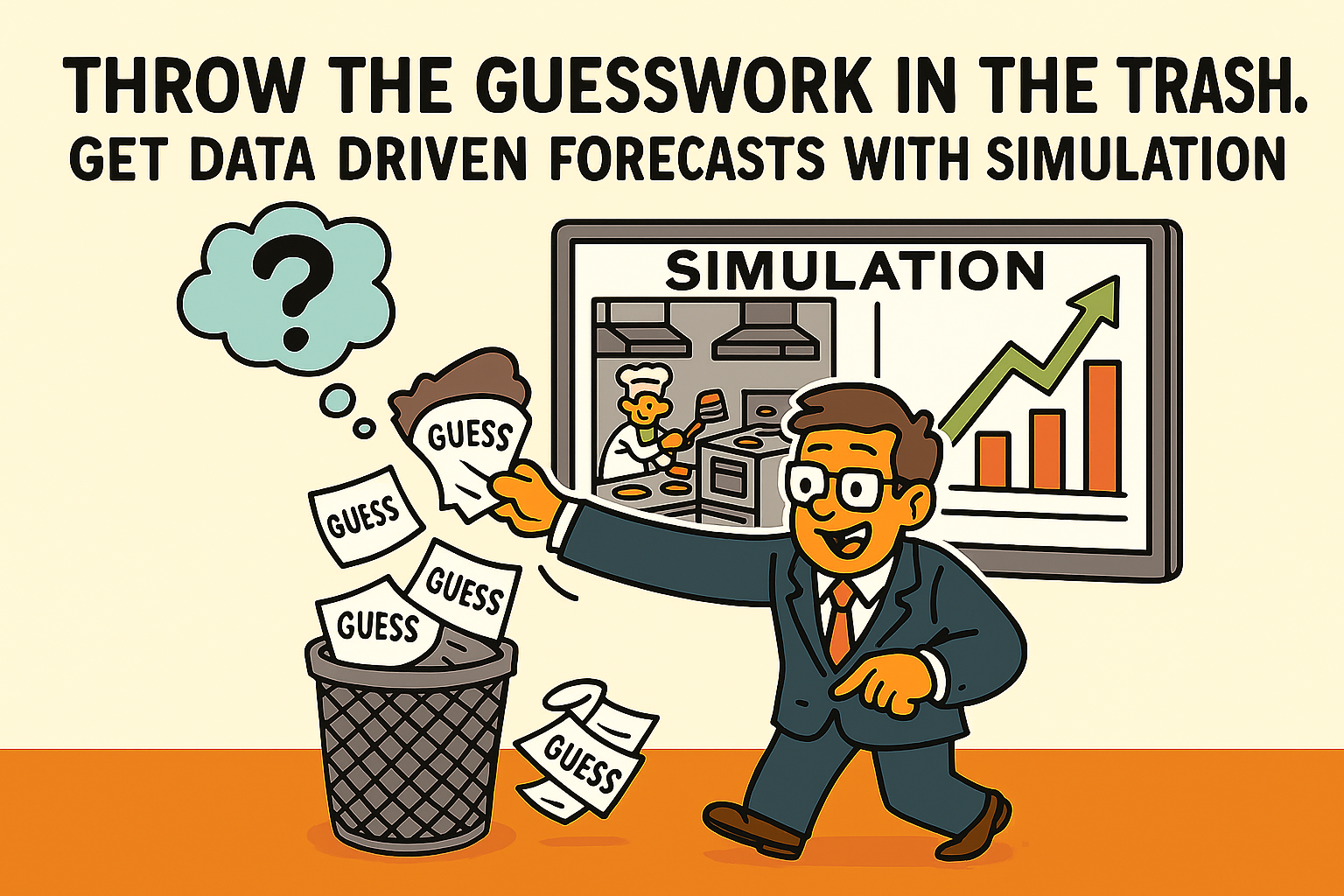
When McDonald's wanted to expand all-day breakfast to additional menu items across 14,000 restaurants, they faced a nightmare scenario. The complexity was staggering: new equipment requirements, space constraints, menu complications, and supply chain challenges that could have cost millions if handled wrong.
Instead of making educated guesses about kitchen configurations and staffing levels, McDonald's created a comprehensive simulation model. The result: optimized equipment purchases, precise staffing recommendations, and the best possible financial yield for their massive menu expansion. The difference between success and catastrophic failure wasn't luck or intuition; it was the power of simulation to predict outcomes before committing resources.
Due to a stubborn addiction to the “tweak and hope” method of process improvement, most organizations continue making educated guesses about their operations, leaving 20-30% of their revenue on the table every single year.
On the other hand, a growing number of companies have discovered something powerful: business process simulation. These early adopters are systematically cutting costs by 25-30%, compressing cycle times, and unlocking ROI in as little as six months. The difference between winners and losers isn't talent or resources; it's whether they're making decisions based on data or hunches.
The era of process guesswork is over. Here's why simulation has become the new baseline for competitive operations.
The Brutal Math of Making Assumptions
Let's start with a reality check that should make every executive uncomfortable. According to comprehensive industry research, companies forfeit 20-30% of annual revenue to process inefficiencies. Think about that for a moment. If your company generates $100 million annually, you're potentially leaving $20-30 million on the table simply because your processes aren't optimized.
But the revenue leak is just the beginning. Skilled workers lose 60% of their time to manual coordination and rework. Meanwhile, organizations that don't employ simulation experience 28% more process-related issues and 40% more downtime compared to those using data-driven modeling.
These aren't abstract statistics. They represent the measurable price of making process decisions without proper analysis. Every time leadership says "let's try this approach and see what happens," they're essentially gambling with company resources.
The Simulation Advantage Across Industries
The beauty of process simulation lies in its universal applicability. Across every major industry, companies are discovering that virtual testing delivers quantifiable benefits with surprisingly fast payback periods.
In manufacturing, assembly-line redesign through simulation has delivered 25% labor-cost reductions and 15% throughput increases, with payback periods of just six months. Healthcare organizations using simulation for emergency-department patient flow have seen 30% increases in patient throughput in under 12 months.
Retail companies applying simulation to inventory optimization report 20% less excess stock and 10% sales uplift within three months. Aviation firms using simulation for aircraft turnaround scheduling have shaved 15 minutes off each flight, enabling more daily rotations with a nine-month payback period. Even in banking, loan-approval workflow simulation has cut cycle times by 50% with six-month payback periods.
The pattern is consistent: companies that simulate before they implement see double-digit improvements across their key metrics, often within the first year.
How Simulation Converts Insight into Action
Traditional process analysis tools like BPMN diagrams provide static snapshots of how work should flow. Simulation goes several steps further by creating dynamic models that reveal what actually happens under real-world conditions. The best solutions offer both BPMN modeling and simulation.
Data-driven "what-if" testing allows organizations to stress-test scenarios virtually before rolling them out. This approach explains why simulation users report 28% fewer process problems and 40% less downtime; they've already identified and fixed potential issues in the virtual environment.
Discrete-event models identify constraint points that remain invisible in static diagrams. These bottleneck discoveries typically cut total lead times by double-digit percentages. Resource and cost optimization through simulation-guided redesign routinely delivers 25-30% operational cost reductions.
Perhaps most importantly, simulation provides visual, quantitative evidence that accelerates stakeholder buy-in. Instead of lengthy debates about theoretical improvements, leadership teams can see concrete projections of costs, timelines, and outcomes. This evidence-based approach is why 70% of technology leaders are now actively funding digital-twin initiatives.
The Market Has Already Decided
While some companies debate whether simulation is worth the investment, the broader market has already reached a verdict. The business-process simulation software market is projected to grow from $3.8 billion in 2023 to $9.2 billion by 2033, representing a 9.2% compound annual growth rate.
The broader simulation software market shows even more dramatic growth, expanding from $27.2 billion in 2025 to an estimated $87.2 billion by 2034. Most telling of all, the digital-twin market is racing from €16.6 billion in 2025 toward €242 billion by 2032, representing a staggering 39.8% annual growth rate.
These aren't speculative bubbles. They represent systematic adoption by organizations that have discovered simulation's ability to transform ambiguous discussions into quantified business cases. When Aberdeen Group research shows that firms using simulation suffer 28% fewer process issues and 40% less downtime, the business case becomes clear.
Avoiding the Common Pitfalls
Like any powerful tool, simulation requires thoughtful implementation to deliver maximum value. The most common pitfall is the "garbage in, garbage out" problem, where poor or outdated data leads to misleading recommendations. The mitigation is straightforward: prioritize high-quality, current data feeds and validate against reality.
Over-complicated models represent another common trap. When simulation becomes too complex, stakeholders disengage and iterations slow down. The solution is starting small and incrementally adding complexity once baseline accuracy is proven.
Perhaps most dangerous is the lack of validation loops, which can create false confidence in results. Always compare simulated outputs with real-world KPIs before scaling changes. This practice ensures that virtual insights translate into actual improvements.
The New Competitive Reality
McKinsey puts it succinctly: "Simulation modeling is transforming the way organizations operate by providing insights that are otherwise hard to capture in the real world." Peter Drucker's famous observation that "the best way to predict the future is to create it" takes on new meaning in the context of process simulation.
IDC Research has documented that strong process discipline delivers revenue growth twice as fast and profitability 30% higher than peers. When you combine this with simulation's ability to eliminate guesswork, the competitive advantage becomes overwhelming.
Organizations continuing to rely on trial-and-error process improvement are essentially choosing to compete with one hand tied behind their backs. They're making strategic decisions based on opinions while their competitors make the same decisions based on data.
The Time to Act is Now
Every data point converges on the same message: continuing to "guess" in process improvement has become a strategic liability. Simulation turns ambiguous discussions into quantified business cases, routinely delivering 25-30% cost reductions, cycle-time cuts achieved in months, and ROI realized within the first year.
In a landscape where inefficiency erodes up to a third of revenue, adopting simulation isn't a nice-to-have capability. It's the new baseline for competitive, resilient operations. The companies that recognize this reality today will be the ones setting the pace in their industries tomorrow.
The question isn't whether your organization will eventually adopt process simulation. The question is whether you'll lead the transition or scramble to catch up after your competitors have already gained the advantage.
Stop guessing. Start knowing. The future of process improvement is here, and it's more precise than you ever imagined.
Stop Guessing.
Start Knowing.
Every day you wait is another day that six-figure savings stay hidden in your processes. Take the first step.





